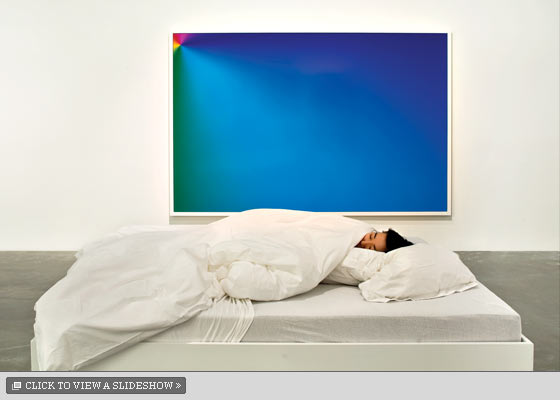 JESUS SAVES
JESUS SAVESJerry Saltz
In the last years of the boom, numerous artists came to the fore who have their aesthetic heads up the aesthetic asses of Gerhard Richter, Andy Warhol, Richard Prince, Cady Noland, and Christopher Wool. They make punkish black-and-white art and ad hoc arrangements of disheveled stuff, architectural fragments, and Xeroxed photos. This art deals in received ideas about appropriation, conceptualism, and institutional critique. It’s a cool school, admired by jargon-wielding academics who write barely readable rhetoric explaining why looking at next to nothing is good for you. Many of these artists have sold a lot of work, and most will be part of a lost generation. They thought they were playing the system; it turned out that they were themselves being played.
The New Museum’s flawed but tantalizing new triennial, “The Generational: Younger Than Jesus” puts this kind of art behind us and points to what might lie beyond that recycling machine. It’s a big show, assembled by a big crowd: The New Museum asked 150 recognized artists, critics, and curators to recommend artists. They put together a list of 500 or so, and three in-house curators—Lauren Cornell, Massimiliano Gioni, and Laura Hoptman (a Millennial, Gen-Xer, and Boomer, respectively)—sifted through it to create the final building-filling show of 50 artists from 25 countries. A swell 564-page “artist directory,” showcasing the hundreds of artists who were seriously considered but didn’t make the final cut, accompanies “Younger” and makes this one of the most refreshingly transparent exhibitions ever organized. (It’s a kind of salon des réfusés in book form.)
All the artists here were born after 1976 (and are therefore under 33, Christ’s age at his death). Their generation is variously called the Millennials (is that a Pixar film? Or a pop band?), Generation Y, iGeneration, Generation Me, or (my favorite) Generation OMG! Most of the artists are not undiscovered—three have been on art-magazine covers already, and many have been in museum shows and have sold work to famous collectors—but few are well known in the United States.
“Younger” has its frustrating moments, and most of them occur when the curators conform too completely to biennial habit, choosing art that follows standard conventions of late-late-late conceptualism. (The fourth floor, in particular, is pretty inert.) Anna Molska’s video of two boys in gladiatorial jockstraps assembling a multipart black cube is cute, but it’s just one more commentary on early-twentieth-century art. Cao Fei’s formulaic forays into role-playing are flashy but only navel-gazing fun. Loris Gréaud’s turning spiral staircase is typical of the kind of art whose labels tell you more than the work does; in this case, we read that the title, Nothing Is True, Everything Is Permitted, Stairway Edit, refers to “an eleventh-century Nizari Ismaili mystical sect” and that the staircase “will never take you anywhere.” (The label fails to mention that the piece looks like a retail-store display.) Cory Arcangel is a good artist, but his chromogenic print of a color spectrum is a decorative one-liner. It’s tenth-generation art about art about the monochrome.
But then there are the tantalizers, and they make you see how art is changing. The show suggests that ideas about culture, ethnography, anthropology, and sociology, YouTube and Facebook, and science and documentary film have all become more important than October magazine postmodernism. Sociology is the new black. None of these artists is trying to advance the teleological ball or invent new forms. They’re investigating the whole world, not just the art world. Their work is less about how we affect time and people than about how time and people affect us.
That’s a welcome switch from the super-self-conscious, highly educated, insular art of the recent past. The best artists in “Younger” turn their gaze from their own belly buttons to gaze at other people’s belly buttons. They simultaneously occupy conflicting positions, are more sincere than ironic but ironic nevertheless, and see the world, not just art, as a living specimen. Better yet, they do this by violating the idiotic academic proscriptions against visual pleasure. (The theory folks disdain pleasure in art, all the while embracing it in their lives.) Their work has what theorist Gayatri Spivak called “radical vulnerability” and is an attempt to explore the substrata of knowledge and experience.
A number of artists delight, but several blew me away. Cyprien Gaillard’s riveting 30-minute video, Desniansky Raion, with its pulsing soundtrack by the amazing French musician Koudlam, gives us beautifully choreographed footage of two huge gangs of Russian “underground fight clubs” squaring off and charging, then beating the crap out of one another, in a St. Petersburg housing complex. Next, in a public-housing project on the outskirts of Paris, we see a fireworks display over a building that is then blown up. Finally, we see footage of an ugly, snow-covered Kiev apartment block shot illegally from a miniature airplane. It’s an amazing video, a harrowing record of ancient rituals’ being revived in new ways in unexpected places, and a picture of our new cities of ruin.
No hay comentarios:
Publicar un comentario